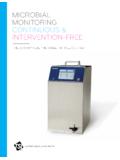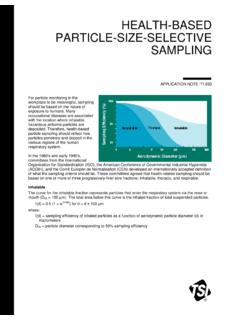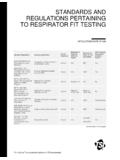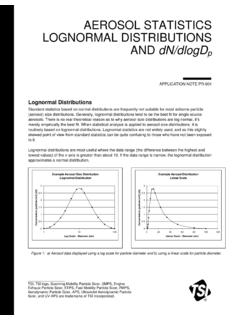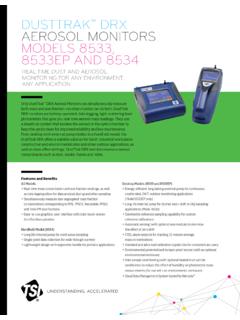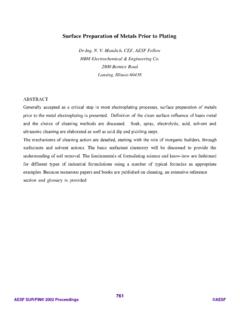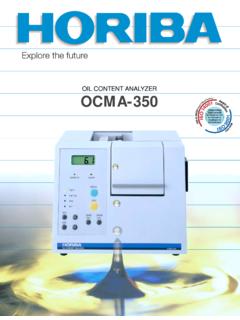Transcription of PHOTO-IONIZATION DETECTION (PID) …
1 PHOTO-IONIZATION DETECTION (PID) TECHNOLOGY APPLICATION NOTE TSI-147 How does a PID work? TSI measures Volatile Organic Compounds (VOCs) in air by PHOTO-IONIZATION DETECTION (PID). A PID uses an ultraviolet (UV) light source to break down VOCs in the air into positive and negative ions. The PID then detects or measures the charge of the ionized gas, with the charge being a function of the concentration of VOCs in the air. Note that the gas ions recombine to reform the original gas or vapor, so PIDs do not burn or otherwise permanently change the sample gas.
2 What is a volatile organic compound (VOC)? A volatile organic compound, or VOC, is a carbon -containing chemical, which is significantly or completely vaporized at ambient temperatures. What volatile organic compounds (VOCs) are sensed by PIDs? Most VOCs can be detected by PIDs, with the notable exceptions of low molecular weight hydrocarbons. Each VOC has a characteristic threshold energy of light (photon energy) which, when directed at the VOC, causes it to fragment into ions. This is called the ionization Potential, or IP. VOCs are ionized (and hence detected) if light of photon energy greater than the IP interacts with the gas sample.
3 The photon energy is measured in electron-volts (eV), which is analogous to how common light bulbs are measured in watts. PID lamps can be created with a number of gasses, each of which has different photon energy. TSI s PID probes use Krypton gas, with photon energy of eV. While the intensity of PID lamps may change over time, or from lamp to lamp, affecting the absolute VOC measurement, PID sensors with a given lamp type will have the same photon energy. Application Note TSI-148 lists VOCs by their common name and their sensitivity to the Krypton lamp used in our VOC probes.
4 Why use a Krypton ( eV) lamp? The choice of lamp depends on target gases, selectivity requirements and lamp lifetime considerations. Where possible the krypton lamp is used for the high sensitivities it delivers. TSI uses a Krypton ( eV) lamp to balance broadband delectability with long lamp life. Other commonly encountered PID lamps are Xenon ( eV photon energy) and Argon ( eV photon energy). Xenon lamp ( eV) Xenon lamps can detect many aromatics and unsaturated VOCs compounds containing 6 or more carbon atoms. However, PIDs using Xenon lamps cannot detect VOCs containing 2, 3 or 4 carbon atoms, limiting their broadband usability.
5 Xenon lamps have long life. -2- Krypton lamp ( eV) Krypton lamps can detect the same VOCs as the Xenon lamp, plus may compounds containing 2, 3 or 4 carbon atoms. For guidance, you can expect the following to be detected with TSI s Krypton PID: All hydrocarbons, whose chemical names end in the letters ane, ene or yne o except methane, ethane, propane, and acetylene o except some names with chloro-, fluoro- or bromo- All alcohol s whose chemical names end in ol o except methanol o except some names with chloro-, fluoro- or bromo- All aldehydes, whose names end in aldehyde o except formaldehyde o except some names with chloro-, fluoro- or bromo All ketones, whose chemical names end in one o except rarely if the name includes chloro-, fluoro- or bromo.
6 All esters, whose names end in ate o except rarely if the name includes chloro-, fluoro- or bromo-. All amines, sulfides Krypton lamps have similar lifespan to Xenon lamps. Argon lamp ( eV) All VOCs detectable with the kryton lamp, plus acetylene, methanol, formaldehyde and about 80% of VOCs whose chemical names include chloro-, fluoro- and However, this lamp has a very short lifetime because the UV window is made from Lithium Fluoride, which is prone to degradation. Are there other ways to measure VOCs? PIDs show excellent sensitivity, a large dynamic range and allow ppb-low ppm measurement of VOCs in a background of higher inorganic gas concentrations.
7 But there are other technologies to measure VOCs: Colorimetric ( Stain ) tubes Colorimetric, or Drager , tubes have been around for years. They are a proven, inexpensive method of measuring toxic gasses and vapors. However, colorimetric tubes do have limitations. They can only be used to check conditions at 1 point in time, whereas TSI s PID sensors can be used for continuous measurements. Colorimetric tubes are also slower to respond, giving readings in minutes instead of seconds. Tube readings take the form of color change, so their measurement requires human interpretation.
8 Accuracy of tube readings is also dependent upon the accuracy of the flow sampling device used. Colorimetric tubes may or may not have the required chemistry to identify the compounds encountered. Flame Ionisation Detectors (FID) FIDs are frequently used in laboratories for detecting VOCs. FIDs, like PIDs, are not selective; indeed all organic compounds including methane are detected. FIDs can be very sensitive and linear. FIDs are good in the lab or for fixed sites, but are not for portable VOC monitoring due to the size, weight and the need for a hydrogen cylinder.
9 TSI Incorporated Visit our website for more information. USA Tel: +1 800 874 2811 UK Tel: +44 149 4 459200 France Tel: +33 4 91 11 87 64 Germany Tel: +49 241 523030 India Tel: +91 80 67877200 China Tel: +86 10 8251 6588 Singapore Tel: +65 6595 6388 TSI-147 Rev. B 2013 TSI Incorporated Printed in Thermal Desorption or Tedlar sampling bags For retrospective analysis of all VOCs adsorbed in soil samples, other solids, liquids and gases, the ASTM recommends using sorbent tubes or Tedlar sampling bags. Samples are then sent to the lab for thermal desorption of the sorbent tubes and then analysis using GC/MS.
10 This is the best technique when surveying a specific problem, but clearly does not provide DETECTION in real time. Also, these averaged measurements can be expensive. Metal Oxide Semiconductor sensors (MOS) Metal oxide sensors will also measure VOCs. They are compact and low cost sensors. MOS sensors suffer from humidity sensitivity, non-linear response and long term drift. They also respond to inorganic gases, so you should not use them if you are trying to measure low concentrations of VOCs where gases such as NO, NO2 or CO are present in higher concentrations.

